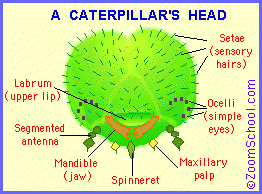 Butterfly and Moth Senses Butterfly and Moth Senses Butterflies use their senses of sight, touch, hearing, smell, and taste to survive in the world, find food and mates, lay eggs in an appropriate place, migrate, and avoid hungry predators. Caterpillars can sense touch, taste, smell, sound, and light. Butterflies use their senses of sight, touch, hearing, smell, and taste to survive in the world, find food and mates, lay eggs in an appropriate place, migrate, and avoid hungry predators. Caterpillars can sense touch, taste, smell, sound, and light.
SIGHT
The vision of butterflies and moths changes radically in their different stages of life.
 Caterpillars can barely see at all. They have simple eyes (ocelli) which can only differentiate dark from light; they cannot form an image. They are composed of photoreceptors (light-sensitive cells) and pigments. Most caterpillars have a semi-circular ring of six ocelli on each side of the head. Caterpillars can barely see at all. They have simple eyes (ocelli) which can only differentiate dark from light; they cannot form an image. They are composed of photoreceptors (light-sensitive cells) and pigments. Most caterpillars have a semi-circular ring of six ocelli on each side of the head.
Butterflies and moths (like many other adult insects) have compound eyes and simple eyes. These eyes are made up of many hexagonal lens/corneas which focus light from each part of the insect's field of view onto a rhabdome (the equivalent of our retina). An optic nerve then carries this information to the insect's brain. They see very differently from us; they can see ultraviolet rays (which are invisible to us).
TOUCH
Caterpillars: A caterpillar's "fuzz" gives it its sense of touch. Caterpillars sense touch using long hairs (called tactile setae) that grow through holes all over their hard exoskeleton. These hairs are attached to nerve cells, and relay information about the touch to the insect's brain.
Butterflies and moths: Setae (sensory hairs) on the insect's entire body (including the antennae) can feel the environment. They also give the insect information about the wind while it is flying.
SMELL AND TASTE
Caterpillars: A caterpillar's maxillae (small mouth parts that are under the mandibles) have taste cells; these chemical detectors tell the caterpillar to eat when the food is appropriate, and not to eat when the food is not appropriate. The tiny antennae, which are near the mouth parts, sense smells.
 Butterflies and moths: A butterfly's antennae, palps, legs,and many other parts of the body are studded with sense receptors that are used to smell. The sense of smell is used for finding food (usually flower nectar), and for finding mates (the female smelling the male's pheromones). Butterflies and moths: A butterfly's antennae, palps, legs,and many other parts of the body are studded with sense receptors that are used to smell. The sense of smell is used for finding food (usually flower nectar), and for finding mates (the female smelling the male's pheromones).
A butterfly's feet have sense organs that can taste the sugar in nectar, letting the butterfly know if something is good to eat or not. Some females also taste host plants (using organs on their legs) in order to find appropriate places to lay their eggs.
These receptors (called chemoreceptors) are nerve cells on the body's surface which react to certain chemicals. We have similar receptors in our nose and on our tongue.
HEARING
Caterpillars startle at loud noises.
Butterflies and moths hear sounds through their wings.
BALANCE
Butterflies and moths: Johnston's organ is an organ at the base of a butterfly's antennae. This organ are responsible for maintaining the butterfly's sense of balance and orientation, especially during flight.
|
 Free Forum Hosting
Free Forum Hosting